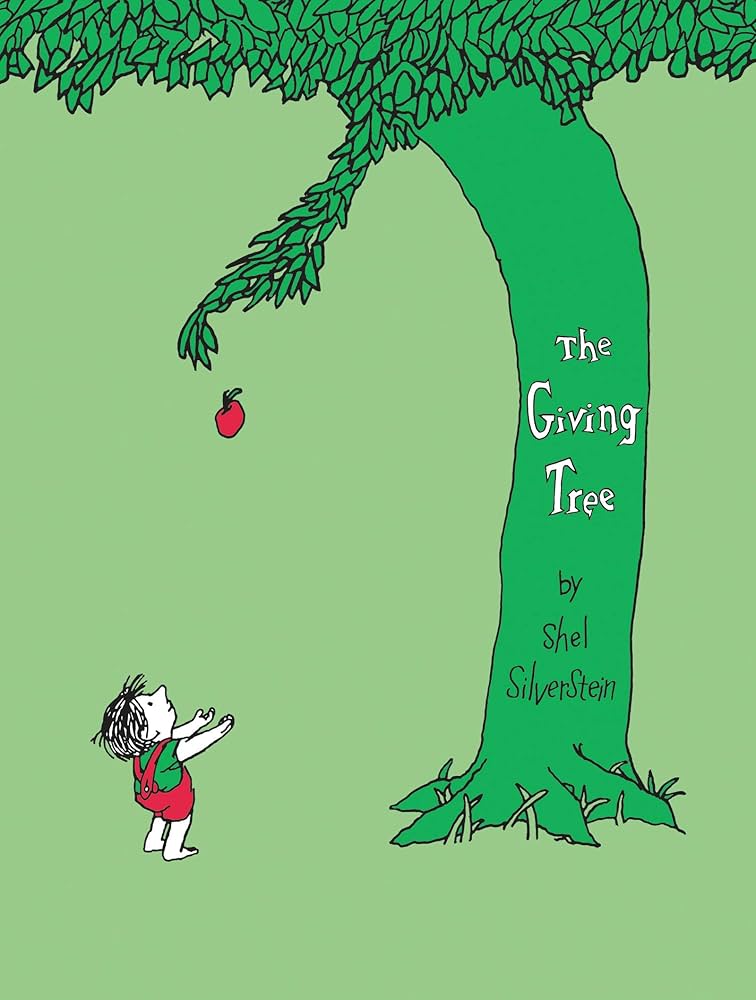The Giving Tree Problem: Why Nonprofit Workers Deserve Boundaries

"And the tree was happy... but not really."
If you've ever worked in the nonprofit sector, you've probably felt that quiet, persistent pressure to keep giving, no matter the cost. The late nights that blur into early mornings, the skipped meals at your desk, the "just one more client" mentality that stretches your day into evening. These behaviors aren't just normalized in nonprofit culture; they're often celebrated as badges of honor, proof of your passion and dedication to the cause.
But beneath the praise and the mission-driven rhetoric lies a dangerous myth that's slowly consuming our sector from within: that the best nonprofit workers are the ones who give until there's nothing left of themselves.
The Story We Tell Ourselves
This myth didn't emerge in a vacuum. It has deep roots in our collective storytelling, and one of the clearest examples is on countless childhood bookshelves: Shel Silverstein's The Giving Tree.
In this seemingly innocent tale, we watch a tree give its apples to feed a boy, then its branches so he can build a house, then its trunk so he can make a boat. Finally, all that remains is a weathered stump where an old man can rest his weary bones. And the tree? The tree calls this love. The tree is "happy."
But let's pause here and ask the question that the book never does: What if the tree isn't actually happy? What if this isn't love at all?
When we read this story through the lens of modern psychology and workplace dynamics, what we're really seeing is a textbook case of codependency, exploitation, and complete boundary collapse. The tree gives compulsively, the boy takes without reciprocation, and the relationship continues until one party is literally reduced to nothing.
Sound familiar? It should. It's the same pattern playing out in nonprofit organizations across the country every single day.
The Cultural Roots Run Deep
The "selfless servant" archetype isn't new, and it's not accidental. From missionary culture to military service, from faith-based charity work to the broader tradition of women's unpaid care work, our society has long praised the idea of service without limits. We've romanticized the notion that true compassion requires self-sacrifice, that real impact demands personal cost.
This narrative has been particularly damaging for women and people of color in the nonprofit sector, who have historically been expected to carry invisible emotional and organizational labor—the "glue work" that holds organizations together but rarely appears in job descriptions or performance reviews. They're expected to be the eternal nurturers, the ones who smooth over conflicts, remember birthdays, and somehow make everyone feel cared for while their own needs remain invisible.
The Intersection of Identity and Exploitation
Research shows that women of color in nonprofit leadership roles are disproportionately likely to experience what psychologists call "superwoman syndrome"—the pressure to excel in all areas while suppressing their own needs and emotions. They're caught in a double bind: criticized if they assert boundaries (seen as "difficult" or "not a team player") and burned out if they don't.
This isn't just individual struggle; it's systemic exploitation wrapped in the language of purpose and mission.
The Real Cost of Giving Without Limits
When we dig beneath the surface of nonprofit culture, the costs of this endless-giving mentality become starkly clear:
Physical and Mental Health
- Chronic stress symptoms: Migraines, insomnia, digestive issues, and autoimmune flare-ups become so common that they're treated as occupational hazards
- Mental health impacts: Anxiety, depression, and what researchers now recognize as "empathy fatigue." This is the emotional exhaustion that comes from caring for others without caring for yourself
- Substance use: Higher rates of alcohol and prescription drug use as coping mechanisms for chronic stress
Relationships and Personal Life
- Family strain: Missing school plays, postponed vacations, and relationships that suffer from constant work intrusion
- Social isolation: When your identity becomes so wrapped up in your work that you lose touch with who you are outside of it
- Romantic relationships: Partners who feel like they're competing with your job for attention and emotional availability
Professional Impact
- Decreased effectiveness: Burnout doesn't just make you tired; it makes you less creative, less strategic, and less able to think beyond immediate crises
- High turnover: The sector's notorious revolving door, with average tenure in nonprofit jobs dropping to just 2.3 years
- Organizational dysfunction: When everyone is burned out, toxic patterns become normalized and go unchallenged
The numbers tell the story: nearly half of nonprofit employees report being emotionally exhausted, with 67% citing chronic overwork and inadequate support as primary factors (Nonprofit HR, 2022). These statistics represent real people whose passion for justice has been weaponized against their well-being.
Zooming Out: The Forest of Stumps
Now imagine zooming out from Silverstein's single giving tree. Instead of one lonely stump, picture an entire forest, acre after acre of weathered stumps where thriving trees once stood. This is what the nonprofit sector looks like when we normalize boundary-less giving: an ecosystem stripped bare, unable to regenerate or sustain itself.
The irony is that the communities we're trying to serve suffer too. When nonprofit workers are burned out, disengaged, and constantly turning over, the very people who need consistent, creative, passionate advocacy receive inconsistent, depleted, survival-mode service instead.
We've created a system where caring too much becomes a professional liability, where the most dedicated people are the most likely to flame out, and where "sustainability" is treated as a luxury rather than a necessity.
The Radical Reframe: Boundaries as Life Force
Here's the paradigm shift that can save both individual nonprofit workers and the sector as a whole: boundaries are what make sustainable, good work possible.
Instead of seeing boundaries as selfish walls that keep you from serving others, think of them as the essential elements that allow any living system to thrive: sunlight, soil, water, and space to grow. Boundaries don't diminish your capacity to serve; they protect and nurture it.
What Healthy Boundaries Actually Look Like
Time Boundaries:
- Leaving the office by 6 PM without checking email until the next morning
- Taking your full lunch break away from your desk (preferably outside)
- Using all of your vacation days for actual rest, not "working from a different location"
- Having one day per weekend that's completely work-free
Emotional Boundaries:
- Not taking on your clients' trauma as your own
- Saying "I care about you, and I can't fix this particular problem for you"
- Referring clients to other resources when their needs exceed your role
- Protecting your personal relationships from becoming unpaid therapy sessions about work stress
Professional Boundaries:
- Clearly defining your job responsibilities and sticking to them
- Saying "That sounds important, and it's outside my role" when new duties creep in
- Asking for additional compensation when taking on additional responsibilities
- Not being available for every crisis that arises
Physical Boundaries:
- Taking sick days when you're actually sick
- Not working through pain or exhaustion
- Insisting on ergonomic workspace setup
- Protecting your physical space and belongings at work
The Discomfort Is the Point
The thing that no one tells you about setting boundaries is that it will make some people uncomfortable. Colleagues who've benefited from your endless availability might push back. Supervisors who've relied on your willingness to do extra work for no extra pay might question your "commitment to the mission."
Their discomfort isn't a sign that you're doing something wrong; it's often proof that you're disrupting a broken system. As author and researcher Brené Brown puts it: "Daring to set boundaries is about having the courage to love ourselves even when we risk disappointing others."
Practical Strategies for Boundary Implementation
Start Small, Start Now
- This week: Leave work 15 minutes earlier than usual, just once
- This month: Take one full lunch break outside the office every week
- This quarter: Use one mental health day for actual rest, not catching up on personal errands
Scripts for Common Situations
When asked to take on additional work: "I want to make sure I can give this the attention it deserves. Given my current commitments, I could either take this on and move [specific project] to next month, or we could discuss bringing in additional support. What would work best?"
When clients contact you outside normal hours: "I received your message and want to give it proper attention. I'll respond to non-emergency communications during business hours. If this is an emergency, please contact [emergency resource]."
When feeling pressure to work through illness: "I need to take a sick day today to recover properly. I'll be back tomorrow and fully present rather than pushing through and potentially being less effective all week."
Building Organizational Support
Individual boundaries are essential, but they're not enough. We also need to advocate for systemic changes:
- Workload audits: Regular assessments of whether job descriptions match actual expectations
- Compensation equity: Ensuring that passion for the mission doesn't subsidize inadequate pay
- Mental health benefits: Robust EAP programs and mental health coverage
- Leadership accountability: Holding managers responsible for modeling and respecting boundaries
The Deeper Philosophy: Audre Lorde's Wisdom
The late poet and activist Audre Lorde gave us perhaps the most powerful reframe of self-care in social justice work: "Caring for myself is not self-indulgence. It is self-preservation. And that is an act of political warfare."
Lorde understood something that many in the nonprofit sector still struggle with: in systems designed to exploit our compassion, taking care of ourselves becomes a radical act. It's a refusal to let our passion be weaponized against our well-being and an insistence that we deserve to be whole people, not just vessels for service.
When we set boundaries, we're modeling what it looks like to build a sustainable movement for change. We're showing the world that justice work doesn't require martyrdom, and that social change can happen through joy and abundance rather than just sacrifice and scarcity.
Moving Forward: Questions for Reflection
As you think about your own relationship with boundaries in nonprofit work, consider these questions:
Personal Reflection:
- Where have I been praised specifically for abandoning my own needs?
- What would change in my work if I protected my time and energy with the same fierceness I protect my clients' needs?
- What story do I tell myself about why I "have to" say yes to every request?
Professional Assessment:
- What's one boundary I could implement this week that would make the biggest difference in my well-being?
- How do I know when I'm approaching burnout, and what early warning systems can I put in place?
- What would it look like to advocate for boundary-supporting policies at my organization?
Movement Building:
- How can I model healthy boundaries for my colleagues, especially those who are newer to nonprofit work?
- What would the social justice movement look like if it were built on sustainability rather than sacrifice?
- How can I support other nonprofit workers in setting and maintaining their own boundaries?
The Forest We're Planting
The truth that The Giving Tree never teaches us is that real love, real impact, and real change don't demand your destruction. They require you to be present, whole, and rooted for the long haul.
The work you care about needs your brilliance, creativity, strategic thinking, and persistent hope over many years; you model what it looks like to fight for justice while also fighting for your own right to exist as a full human being.
When we choose boundaries, we're planting seeds for a different kind of forest, one where every tree has room to grow, where the ecosystem is sustainable, and where the work of justice can continue for generations.
The choice is ours: we can keep telling the story of the giving tree, celebrating depletion as dedication. Or we can write a new story, one where caring for ourselves is part of caring for the world, where boundaries are acts of love, and where the forest stays alive because every tree knows how to say both "yes" and "no."
Your mission needs you to be healthy, your community needs you whole, and you deserve to thrive, not just survive, in the work that calls to your heart.
You deserve to be more than a stump.
---------------------------------------------------------------------
Don't forget to listen to the companion podcast episode, The Myth of the Selfless Servant: Why Boundaries Matter for even more insights and practical tips on combating burnout in the nonprofit sector.











